Oscillation Reduction of Breast for Cup-Pad Choice
LIU Shiyuan(刘世媛), SUN Guangwu(孙光武), 2*, CHEN Xiaona(陈晓娜), HU Hongyan(胡红艳)
1 School of Textiles and Fashion, Textile Industrial Key Laboratory of Sports Ergonomics and Functional Clothing, Shanghai University of Engineering Science, Shanghai 201620, China 2 Mechanical and Electrical Engineering College, Hainan Vocational University of Science and Technology, Haikou 571126, China
Abstract:Traditional studies of evaluating breast displacement included cup fabrics, shoulder straps, and under-bands restricted by own features of sports bras (SBs). The effects of pads on breast support during movement were investigated by conducting trials with the motion capture experiment. The three-dimensional breast displacements at five breast positions were collected and values in the vertical direction were evaluated. Results indicate that the effectiveness of the cup pad depends on the pad diameter and the thickness. SBs with larger pads and thicker pads made of soft polyurethane cause less overall breast displacement during vertical jumping compared to unpadded bras (p<0.05). The effectiveness of bra oscillation reduction was characterized by the total reduced percentage of the breast displacement. These findings enlarge scopes in terms of the current breast displacement analysis and understanding of selecting SBs associated with changes in the specifications of pads, thereby providing objective methods for bra cup evaluation and a design basis for breast protection.
Key words:cup-pad; sports bra; breast kinematics; vertical jumping
0 Introduction
The female breast contains limited anatomical support owing to the lack of muscles and bones[1]. It is reported that a significant percentage of women experienced sports-related breast mastalgia[2-4]. The main cause of these consequences is excessive breast oscillation (BO)[5]. During exercise, the impact load generated by the feet against the ground is transmitted to the musculoskeletal system throughout the body, which triggers oscillations in the breasts[6]. This oscillation is a deterrent to exercise participation among women and can be reduced by wearing sports bras (SBs) which are designed to provide good breast external support during vigorous activities[5, 7]. Over the past decades, a plethora of breast biomechanics literature has verified that subassemblies of SBs including bra cups, shoulder straps, under-bands, and cup-pads (CPs) are fundamental in terms of reducing BO[8-10]. For instance, bra cups made of high elastic modulus fabrics[4, 11]or formed by larger coverage could strengthen breast support[8-9, 12-13]. In addition, shoulder straps are essential to support the breast mass and hold the breast in place with limited BO[9, 14-16]. Widening and tightening the under-band of SBs could also provide more powerful support with the increased binding force for the breast, and then reduce BO.
The CP, as another subassembly of SBs, is the most important component of the bra cup. With the absence of reliable quantity research, existing research results on the role of pads on the BO reduction are controversial. A previous study suggested that pads could strengthen the interaction force between the compressions acting on the breast by stretched cup fabrics and breasts[17]. It was also demonstrated that when women chose inappropriate pads for the bra cup, the breast would be elevated and compressed in shape rather than controlled in movement[18]. Up to now, there is very little work in the literature that evaluates the effect of different pad specifications on BO during vertical jumping.
In this study, the BO of six subjects wearing the SBs with different thicknesses and sizes of pads is captured, and the effects of different pad specifications on BO during vertical jumping are quantified in a single-factor experiment.
1 Materials and Methods
1.1 Subjects
Six healthy and pre-menopausal adult females with bra sizes of 75B were selected, which were denoted as S1 to S6. Subjects exercised aerobically for 30 min at least twice a week and had the following characteristics: age, (24.5± 1.5) years; body mass, (55.5±3.5) kg; height, (159.5±6.5) cm; no breast surgery; no breastfeeding or no pregnant. The body sizes of all subjects are listed in Table 1. All subjects were informed in advance of the purpose, methods and potential risks of the experiment, and permission to participate in the motion capture experiment were given. The experimental procedures of the study were also approved by the research ethics committee of the local university.

Table 1 List of subject body sizes
1.2 Experimental samples
Circle-shaped polyurethane (PU) pads wrapped by polyester fabrics with a diameter of 12 cm and a thickness of 5 mm, were applied in the experiments. The original pads were cut into samples with different diameters (6 cm and 8 cm) in an attempt to study the effect of the pad coverage on BO. The original pads were stitched into different layers (two and three layers). The slip between different layers could be eliminated by stitching in a central position. All the pad samples are presented in Fig.1. The specifications of the pads are shown in Table 2.
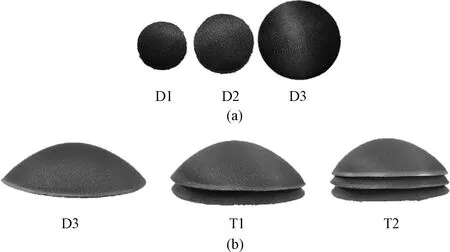
Fig.1 Experimental bra-cup pads: (a) pads with different diameters; (b) pads with different thicknesses
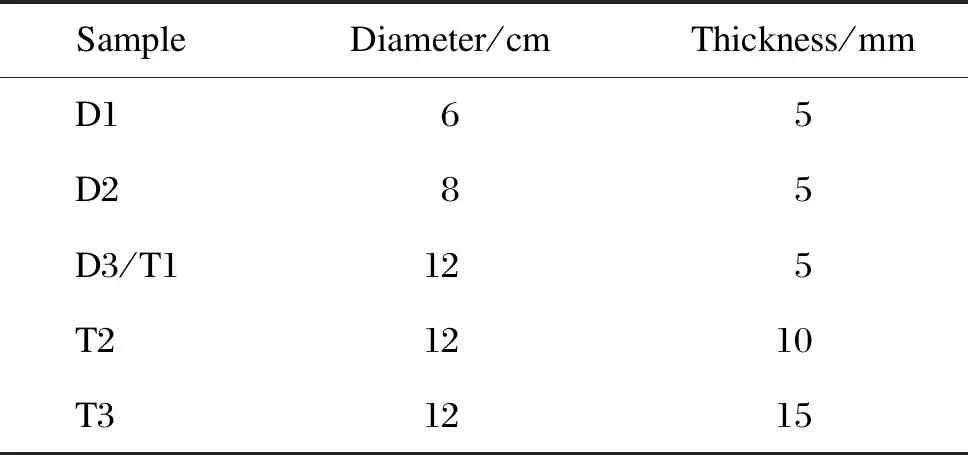
Table 2 Specifications of pads
The bra sample selected in this experiment was a common medium support and professional SB (AUBM204, Lining.com, China), and the extra pads within the cup could be replaced conveniently. The full-cup style offered large coverage for the upper breasts. The SB was designed with splicing fabrics. The front of the SB was composed of three layers of fabrics. The first layer was the main fabric (82% nylon and 18% spandex), and the second and the third layers were inner materials (69% nylon and 31% spandex). The back area was made of light and breathable gauze fabrics (100% polyester). The front and the back views of the SB are presented in Fig.2.
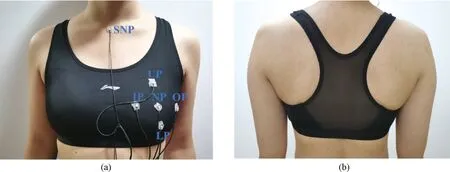
SNP—suprasternal notch position; UP—upper position; OP—outer position; LP—lower position; IP—inner position; NP—nipple position.Fig.2 Experimental SB: (a) front view; (b) back view
1.3 Breast kinematics
Assuming that the body is fully symmetrical, the left breast and the right breast are the same. The left breast was selected as the research object in our study. Most of these studies examined BO only at the nipple[7,13-14,19-20]. However, as the breast tissues are soft and viscoelastic, the breast movement is nonlinear in nature, and the nipple movements may be insufficient to describe the whole breast movement[17]. Thus, to get the nonlinear motion of the breast, through preliminary experiments, we chose the arrangement of the following positions. Active luminous light-emitting diodes (LEDs) (3 mm×2 mm×1 mm) were placed onto the subject’s skin overlying the SNP to establish the breast kinematics relative to the torso, the motion of the SNP stands for the body motion. The other five markers were stuck in the breast region to capture the motion of different positions of the breast as shown in Fig.2 (a), with the NP at the center and the other markers placed 4 cm away from the NP.
The three-dimensional spatial coordinates of each LED were tracked in real-time using four cameras of a CM Tracker system (MC1300, Shanghai Ching Mu Technology Co., Ltd., China) shown in Fig.3. The subject was located 160 cm in the sports zone away from cameras with a sampling frequency of 210 Hz. The task consisted of jumping on the ground under the bare-breast condition, the no-pad sports bra (NB) condition, and the pad (D1, D2, D3/T1, T2, or T3) condition. In the bare-breast experiment, five breast markers were pasted on the breast with medical tapes. During the SB trials, double-sided tapes were indirectly on the breast over the bra fabric[21]. The order of pad conditions was randomized among six subjects. Each subject preliminarily familiarized herself with the specific jump speed, which was timed and controlled by a metronome (110 beat/min) to ensure that the subjects jumped at a consistent stride rate during each experiment. The subjects used medical tapes to attach the LED on the breast according to the locations of the dots marked in Fig.2 (a). Firstly, the subjects confirmed that each measurement point was within the observation range of the camera. Secondly, the subjects wore SBs and changed all specifications of pads in turn, jumped vertically with the metronome, became proficient in the movements, and adjusted their breathing. The dynamic data of the measurement points for 11 s were collected after the speed and the height of the jumps were stabilized. Finally, after the data collection was completed, the subjects rested for 2 min.
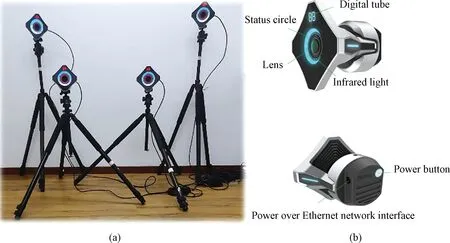
Fig.3 CM Tracker system: (a) four cameras; (b) details of camera
Vertical breast displacement (VBD) during exercises was more than double the magnitude of other directions during vertical jumping[17]. It was why the current study chose to concentrate on the vertical directionZto control the BO during exercises. The raw breast data collected in the motion capture experiment were the absolute breast coordinates at which point the breast displacement included the displacement of the torso and the displacement of the breast relative to the torso. To better characterize the BO, the effect of the torso needed to be removed to obtain the relative displacement of the breast. Most importantly, a performance indicator, reduced percentage of breast displacement (RBD), was introduced. The whole process for calculating RBD is as follows.
Step1All markers’ absolute coordinatesCacan be output from the motion capture experiment. Then the relative coordinateCrof markers is got:
Cr=CSNP-Ca,
(1)
whereCSNPis the relative coordinate of SNP.
Step2Breast displacement relative to the torso is subsequently calculated:
Cr,i=Cmax,i-Cmin,i,
(2)
whereCmax,istands for the maximum relative coordinate inith jump cycle;Cmin,istands for the minimum relative coordinate inith jump cycle.
Step3ThenCr,iobtained from all cycles is averaged as the total breast relative displacement (TBD):
(3)
wherenstands for all jump cycles.
The TBD obtained is thought to be the breast actual displacement in most studies.
Step4RBD is proposed and defined as
(4)
whereDtb,bstands for the breast displacement in the bare-breast condition;Dtb,cpstands for the CP-controlled (D1, D2, D3/T1, T2 and T3) breast displacement. The larger the RBD, the better the oscillation reduction of the CP.
Step5TheRBDof individual markers (UP, IP, NP, OP, and LP) are averaged, and we obtain the total reduced percentage of breast displacement (TRBD).
1.4 Statistical analysis
Significance tests were performed using SPSS software (IBM Corp., Aromink, USA) on the displacements at all locations of the breast in different support states. Firstly, all displacements of the six subjects at five measurement positions were divided into two groups according to the thickness and the size of the pads and tested for normal distribution. The displacements at all locations were found to be normally distributed (p>0.05). One-way ANOVA test was done to confirm whether the difference in the displacement at each measurement point was significant when subjects wore different thicknesses of pads and different sizes of pads.
2 Results and Discussion
2.1 Differences in breast displacement with different pad specifications
The results of the one-way ANOVA test are shown in Table 3. The results showed that the displacements at UP, NP, OP and LP were all significantly different (p<0.05) in different states of breast support, but the displacement at IP was not significantly different (p>0.05) in different states of breast support. This might be due to the fact that IP was on the medial side of the breast, close to the transition zone of the bilateral breast in the anterior centre line of the body. The bra fit the breast worse, which makes it difficult to stabilize the soft breast tissue here.
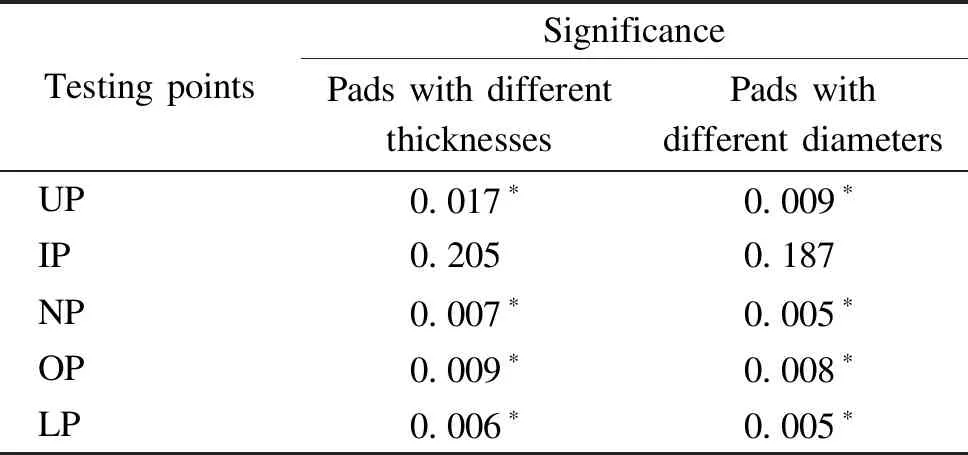
Table 3 One-way ANOVA test results at measurement points in different breast support states
2.2 TBD under different breast support conditions
Figure 4(a) illustrates the TBDs of NB, D1, D2, and D3 pads during vertical jumping. The results show that reductions in the breast displacement increase as the pad diameter increases. It can be especially observed from the mean values that wearing a bra with D2 or D3 pads (p<0.05) greatly reduces the TBD. A padded bra better reduces the breast deformation than a single bra without a pad since the pad embedded in the bra can elevate and compress the breast. For the bra with the D1 pad, the anti-oscillation effect is not obvious. It is mainly because the pads in this study are circle-shaped and put around the nipple, the D1 pad with a diameter of 6 cm only covers the nipples (the smallest diameter), causing the compression forces to dissipate the whole breast. As a result, the breasts as a whole do not receive sufficient pressure and thus the breast displacements are not controlled. In contrast, the diameter of the D3 pad is larger than that of D1 and D2 pads, and the D3 pad could cover the entire breast detection area and greatly reduce breast displacement.
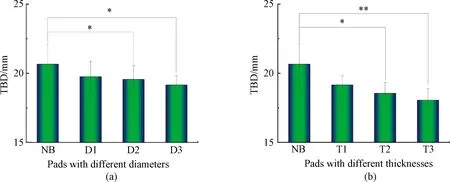
*—0.01 Figure 4(b) illustrates the TBDs of NB, T1, T2, and T3 pads during vertical jumping. There is a significant effect of the bra with the T3 pad on breast movement reduction (p=0.001). With an increase in the pad thickness, the TBD shows a reduction trend. It is found that the thicker the pad, the greater the compression on the breast. It is because thicker pads can stabilize the breasts against the torso wall. Besides, a bra with the thickest T3 pad can provide the greatest breast compression and reduce breast movement. This is because thicker pads can absorb more kinetic energy from fat tissues[22]. The TRBD of the vertical breast displacement under pad-controlled conditions was measured and compared with those under the bare-breast condition. The TRBDs of NB, D1, D2, and D3 pads are 36.11%, 38.87%, 39.41%, and 40.66% respectively as shown in Fig.5(a). Pad diameters show a positive correlation to the BO, indicating that the larger the pad, the better the effect on reducing BO. Figure 5(b) illustrates the TRBDs of NB, T1, T2, and T3 pads during vertical jumping. The TRBDs of NB, T1, and T3 pads are 36.11%, 40.66%, and 43.98%, respectively. The garments with more compression could play a positive role in improving strength and enhance performance including damping of soft tissue oscillations[22]. Especially, the high effect of the T3 pad on breast movement reduction (p=0.001) could lead to stabilization when the breasts are pressed against the torso wall, and the distance from the center of the breast mass to the torso wall is reduced. It could be observed that the D3 pad and the T3 pad greatly reduce the kinematic variables and have larger TRBD with more breast support (Fig.5). The larger and the thicker the pad, the better the damping effect on the breast vibration. These findings are consistent with research found that SB with the additional support of the pads could not only slightly reduce the impact acting on women’s breasts but also compress the breast and buffer the dynamic displacement of the breast during exercise[17]. As a consequence, the force momentum of breast displacement is reduced, restricting the relative displacement between breast tissues and chest muscles. Fig.5 TRBDs under pad-controlled conditions: (a) pads with different diameters; (b) pads with different thicknesses In summary, the influences of different specifications of pads on the movement of the breast during vertical jumping were systematically measured and compared, and the most desirable pad for optimized bra support was identified. The cup pad with larger diameters (D2 and D3 pads) and thicker thicknesses (T2 and T3 pads) could decrease breast movement effectively during exercise. Under the condition of the same thickness, larger pads can cover larger breast surfaces, and thus the BO reduction is greater. Under the condition of the same diameter, thicker pads could compress the breast closer to the torso wall, and thus the BO reduction is greater. The bra samples with different specifications of pads tend to produce different vertical displacements of the breasts during body movement as compared with the bare breast condition. The results could not only guide women to choose suitable cup pads but also provide SB industries with insights on further development of matching functional pads for the design of optimal SB.2.3 TRBD under different breast support conditions
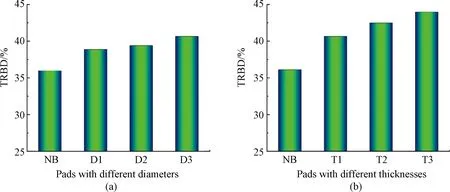
3 Conclusions
 Journal of Donghua University(English Edition)2023年5期
Journal of Donghua University(English Edition)2023年5期
- Journal of Donghua University(English Edition)的其它文章
- Effect of Weft Binding Structure on Compression Properties of Three-Dimensional Woven Spacer Fabrics and Composites
- Optimization for Microbial Degumming of Ramie with Bacillus subtilis DZ5 in Submerged Fermentation by Orthogonal Array Design and Response Surface Methodology
- pth-Moment Stabilization of Hybrid Stochastic Differential Equations by Discrete-Time Feedback Control
- Semantic Path Attention Network Based on Heterogeneous Graphs for Natural Language to SQL Task
- Device Anomaly Detection Algorithm Based on Enhanced Long Short-Term Memory Network
- Image Retrieval Based on Vision Transformer and Masked Learning
